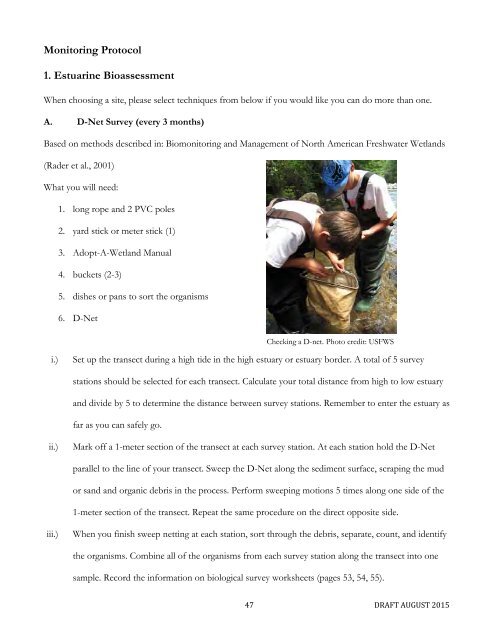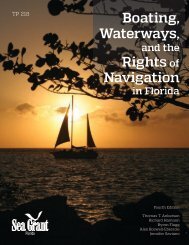Adopt-A-Wetland
XQDrg
XQDrg
Create successful ePaper yourself
Turn your PDF publications into a flip-book with our unique Google optimized e-Paper software.
Monitoring Protocol<br />
1. Estuarine Bioassessment<br />
When choosing a site, please select techniques from below if you would like you can do more than one.<br />
A. D-Net Survey (every 3 months)<br />
Based on methods described in: Biomonitoring and Management of North American Freshwater <strong>Wetland</strong>s<br />
(Rader et al., 2001)<br />
What you will need:<br />
1. long rope and 2 PVC poles<br />
2. yard stick or meter stick (1)<br />
3. <strong>Adopt</strong>-A-<strong>Wetland</strong> Manual<br />
4. buckets (2-3)<br />
5. dishes or pans to sort the organisms<br />
6. D-Net<br />
Checking a D-net. Photo credit: USFWS<br />
i.)<br />
Set up the transect during a high tide in the high estuary or estuary border. A total of 5 survey<br />
stations should be selected for each transect. Calculate your total distance from high to low estuary<br />
and divide by 5 to determine the distance between survey stations. Remember to enter the estuary as<br />
far as you can safely go.<br />
ii.)<br />
Mark off a 1-meter section of the transect at each survey station. At each station hold the D-Net<br />
parallel to the line of your transect. Sweep the D-Net along the sediment surface, scraping the mud<br />
or sand and organic debris in the process. Perform sweeping motions 5 times along one side of the<br />
1-meter section of the transect. Repeat the same procedure on the direct opposite side.<br />
iii.)<br />
When you finish sweep netting at each station, sort through the debris, separate, count, and identify<br />
the organisms. Combine all of the organisms from each survey station along the transect into one<br />
sample. Record the information on biological survey worksheets (pages 53, 54, 55).<br />
47 DRAFT AUGUST 2015



